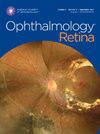Macular Atrophy in Neovascular Age-related Macular Degeneration
IF 4.4
Q1 OPHTHALMOLOGY
引用次数: 0
Abstract
Topic
Macular atrophy incidence in neovascular age-related macular degeneration (AMD) patients undergoing anti-VEGF treatment.
Clinical Relevance
Macular atrophy is a significant event that may occur in eyes with neovascular AMD treated with anti-VEGF therapy.
Methods
We conducted a systematic review and meta-analysis following PRISMA guidelines (PROSPERO, CRD42024474924). A comprehensive literature search of MEDLINE, EMBASE, and Web of Science was performed up to November 1, 2023. Randomized and nonrandomized studies of treatment-naive neovascular AMD patients reporting macular atrophy incidence at 24 ± 3 months after anti-VEGF therapy were eligible. Two independent reviewers conducted screening, data extraction, and quality assessment. For randomized controlled trials, the Cochrane Risk of Bias 2 tool was employed, whereas nonrandomized studies were evaluated using the Risk Of Bias In Nonrandomized Studies of Interventions tool. Random-effects meta-analysis models accounted for study variability. Heterogeneity was assessed with the I2 statistic, and publication bias by funnel plots and Egger test. The primary outcome was the incidence of new macular atrophy at 24 months post-treatment, with secondary outcomes at 12 months. Atrophy was diagnosed using color fundus photograph, fluorescein angiography, fundus autofluorescence, OCT, or multimodal imaging.
Results
Twenty-three studies met the inclusion criteria for qualitative analysis, with 11 included in the meta-analysis (N = 3013 eyes). The pooled 24-month incidence of macular atrophy was 29% (95% confidence interval [CI]: 20%–38%, I2 = 93%). Subgroup analysis revealed incidence rates of 26% (95% CI: 15%–37%, I2 = 88%) for 814 eyes with type 1/2 macular neovascularization (MNV), 49% (95% CI: 18%–80%, I2 = 92%) for type 3 MNV (N = 230 eyes), and 29% (95% CI: 18%–40%, I2 = 96%) for all MNV types (N = 2131 eyes). The pooled 12-month incidence among 2214 eyes was 11% (95% CI: 4%–18%, I2 = 93%). The certainty of evidence, as assessed by Grading of Recommendations, Assessment, Development and Evaluation, was low.
Conclusion
Although this meta-analysis has limitations, including a moderate risk of bias in nonrandomized studies, inconsistencies in the results indicated by high heterogeneity, and imprecision due to the different imaging modalities used to diagnose macular atrophy, our results suggest that macular atrophy could be a common complication in patients with neovascular AMD receiving anti-VEGF therapy.
Financial Disclosure(s)
Proprietary or commercial disclosure may be found in the Footnotes and Disclosures at the end of this article.
新生血管性年龄相关性黄斑变性的黄斑萎缩:一项系统综述和荟萃分析。
主题:接受抗血管内皮生长因子(VEGF)治疗的新生血管性年龄相关性黄斑变性(AMD)患者的黄斑萎缩发生率。临床相关性:黄斑萎缩是用抗vegf治疗的新生血管性AMD患者可能发生的重要事件。方法:我们按照PRISMA指南(PROSPERO, CRD42024474924)进行了系统评价和荟萃分析。对MEDLINE、EMBASE和Web of Science进行了全面的文献检索,截止到2023年11月1日。在抗vegf治疗后24±3个月报告黄斑萎缩发生率的treatment-naïve新生血管性AMD患者的随机和非随机研究符合纳入本综述的条件。两名独立审稿人进行了筛选、数据提取和质量评估。随机对照试验采用Cochrane Risk of Bias 2工具,非随机对照试验采用ROBINS-I工具进行评价。随机效应荟萃分析模型用于定量综合,考虑研究的可变性。异质性采用I2统计量评估,发表偏倚采用漏斗图和Egger检验。主要终点是抗vegf治疗后24个月新发黄斑萎缩的发生率,次要终点是12个月。使用眼底彩色照片(CFP)、荧光素血管造影(FA)、眼底自体荧光(FAF)、光学相干断层扫描(OCT)或多模态成像诊断萎缩。结果:23项研究符合定性分析的纳入标准,其中11项纳入meta分析(N= 3013只眼)。合计24个月黄斑萎缩发生率为29%(95%可信区间[CI]:20%-38%,I2=93%)。亚组分析显示,814只眼1/2型黄斑新生血管(MNV)的发病率为26% (95% CI:15%-37%,I2=88%), 3型MNV (N=230只眼)的发病率为49% (95% CI:18%-80%,I2=92%),所有MNV类型(N= 2131只眼)的发病率为29% (95% CI:18%-40%,I2=96%)。2214只眼睛12个月的总发病率为11% (95% CI:4%-18%,I2=93%)。根据GRADE评估,抗vegf治疗后黄斑萎缩发生率的证据确定性较低。结论:虽然该荟萃分析存在局限性,包括在非随机研究中存在中等偏倚风险,高异质性表明结果不一致,以及由于用于诊断黄斑萎缩的不同成像方式而不精确,但我们的结果表明黄斑萎缩可能是接受抗vegf治疗的新生血管性AMD患者的常见并发症。
本文章由计算机程序翻译,如有差异,请以英文原文为准。
求助全文
约1分钟内获得全文
求助全文

 求助内容:
求助内容: 应助结果提醒方式:
应助结果提醒方式:


